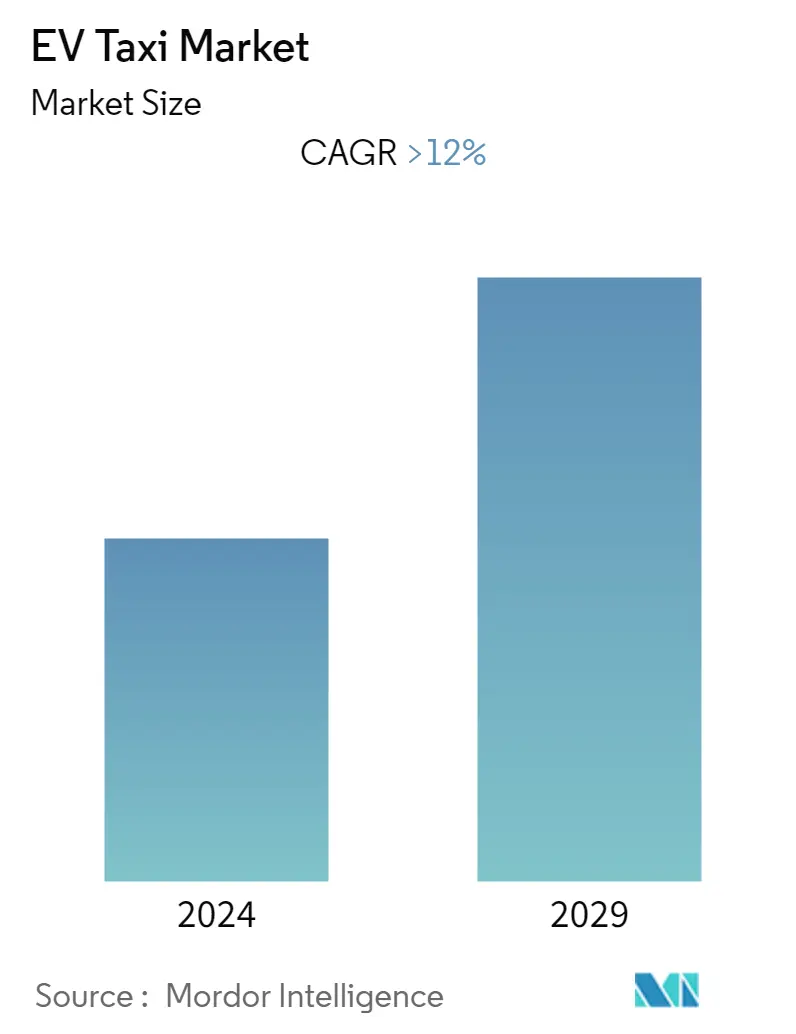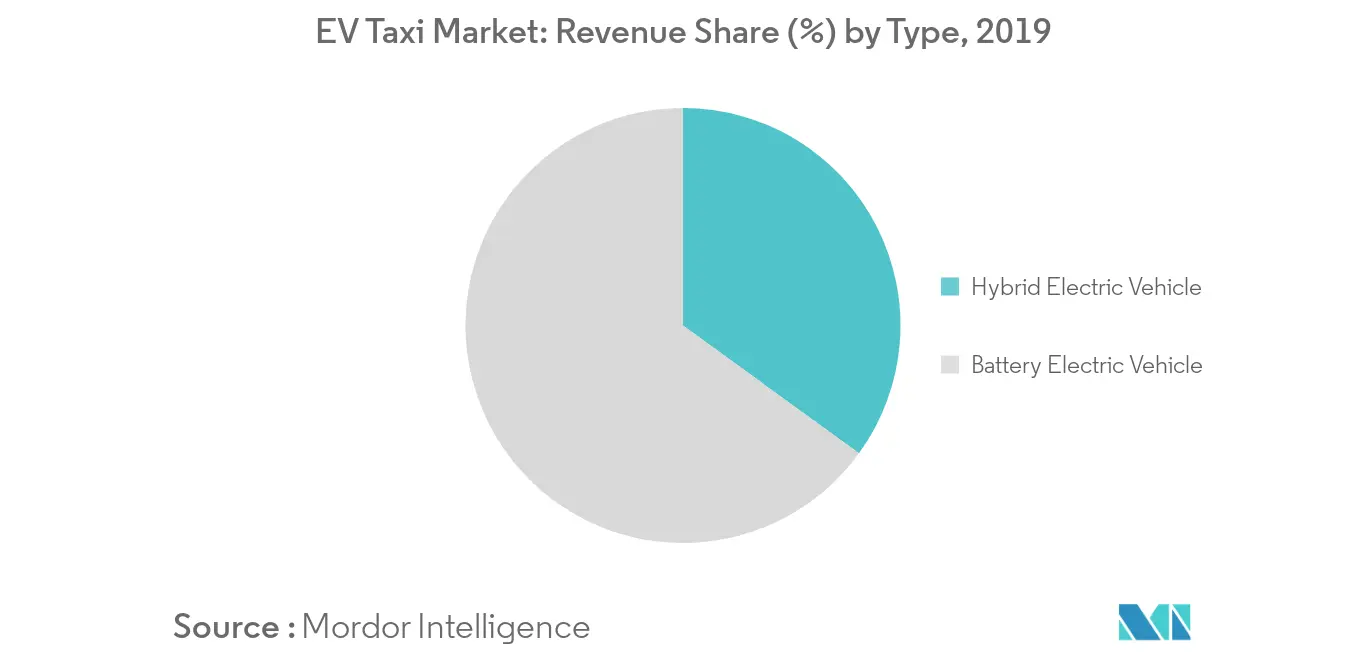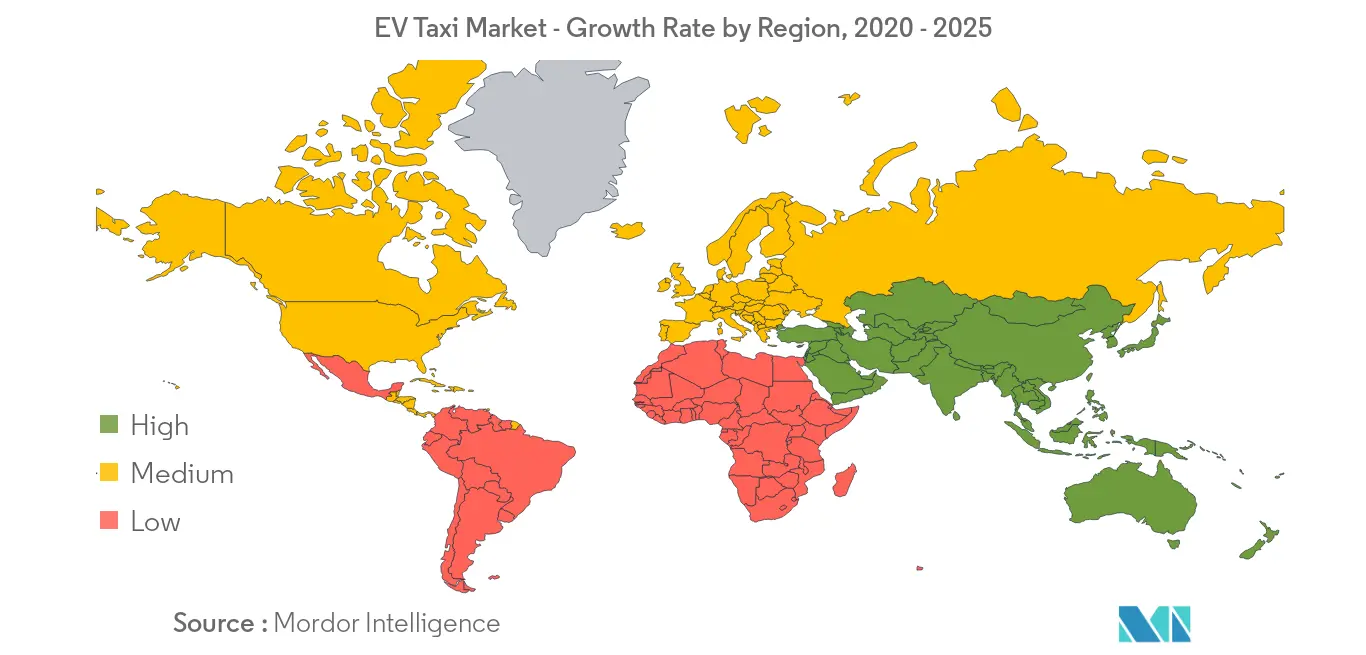Electric Vehicle (EV) Taxi Market Size

| Study Period | 2019 - 2029 |
| Base Year For Estimation | 2023 |
| CAGR | 12.00 % |
| Fastest Growing Market | Asia Pacific |
| Largest Market | Asia Pacific |
| Market Concentration | High |
Major Players
*Disclaimer: Major Players sorted in no particular order |
Electric Vehicle (EV) Taxi Market Analysis
The EV Taxi Market is projected to grow with a CAGR of more than 12 % during the forecast period.
- Owing to the increase in demand for electric vehicles and increasing concerns about pollution caused by vehicles and the government spending on infrastructure for electric vehicles, and initiatives to boost demand for electric vehicles are encouraging the fleet owners to shift towards electric powered vehicles rather than choosing conventional fuel vehicles.
- The lower cost of operation and also the low maintenance cost as compared to the conventional fuel vehicles is likely to enhance the demand in the market. more fleet operators in different parts of the world are trying to shift to electric taxis from conventional fuel based taxis. For instance, Ola Cabs, the biggest fleet operator in India, started a pilot operation of EV taxis in the city of Nagpur to test the viability and feasibility of the project, in 2019.
- However, the battery life and range of the vehicles may be a restraint for the market as electric vehicles taxis are limit to a range of around 250-300 Kms with a full charge.
Electric Vehicle (EV) Taxi Market Trends
This section covers the major market trends shaping the EV Taxi Market according to our research experts:
Government Initiatives and Investment is Boosting the Demand
The demand for electric vehicles is directly linked with the infrastructure available for charging these vehicles in the specific country. Hence, to boost the demand for electric vehicles the governments are continuously increasing their spending to enhance the infrastructure in their region so as to provide sufficient number of charging stations and other financial benefits to the end user so that they are attracted towards these eco-friendly vehicles and reduce the pollution levels in their country.
For instance, in Norway which has a high adoption rate of electric vehicles and there is a waiting list for the delivery of EVs, is enhancing the infrastructure for EV taxis very rapidly. For instance, in March 2019, the Norway government announced that Oslo, which is the capital city of Norway will become first city in the world to install wireless charging systems for electric taxis, hoping to make recharging quick and efficient enough to speed the take up of non-polluting cabs.
China which is the largest market of electric vehicles will invest RMB 10 billion (USD 1.42 billion) in year 2020, to expand the country's charging network by 50% this year to stimulate EV deployment. As of 2019, China had over 1.2 million charging points and with this investment a total of 600,000 charging points will be established.

Asia-Pacific is Remains the Largest Market
The Asia-Pacific region is expected to be the largest market for electric vehicle taxi market. The demand is driven by high adaption rate of electric vehicles in the region and the growing demand for taxi fleet. The region has large economies like India and China which are very highly populated and the demand for taxi services in the region are also growing with the growing rate of urbanization in the region because of the developing nature of these economies.
There are several major players in the region like, BYD which sells 60 % of its pure electric cars for public transport. In 2019, the metropolitan city of Shenzhen in southern China, which is a high-tech hub has reached an environmental milestone of an almost entirely electric-powered taxi fleet, about 99 percent of the 21,689 taxis operating in the city were electric.
Similarly, in India the government is pushing the major fleet operators like Ola, Uber etc. to expand their electric vehicle fleet and convert their 40% of vehicles to electric by the end of 2026. Niti Aayog officials and the ministries of road transport, power, renewable energy and steel, as well as the departments of heavy industries and trade, were among those recommending taxi operators in India gradually convert to electric in India.
In the coming two years Beijing municipal government is planning to replace all gas-powered taxis with electric cars, which will require 20,000 new EVs over the next two years and BAIC will be providing these fleet of electric taxis to Beijing municipal government.

Electric Vehicle (EV) Taxi Industry Overview
The EV Taxi Market is Consolidated, with a few players accounting for a most of the market share. Some of the prominent companies in the EV Taxi Market are Ola, Connexxion, Blue Smaert Mobility and others. These players are investing heavily in research and development of EV for Taxi.
For instance, in November 2019, Ideanomics, a global financial technology company has announced that its Mobile Energy Global (MEG) division has secured an order for 35,000 Electric Vehicle (EV) taxis from the Yunnan Energy Investment Group, which is a province-designated entity for clean energy transportation solutions in China.
Electric Vehicle (EV) Taxi Market Leaders
-
Ola
-
eee-Taxi
-
Blue Smart Mobility
-
Taxi Electric
-
Connexxion
*Disclaimer: Major Players sorted in no particular order

Electric Vehicle (EV) Taxi Market News
Tata Motors on Friday said it has received an order for 3,500 XPRES-T EV units from electric ride-hailing platform BluSmart Mobility. The company said it has inked a Memorandum of Understanding (MoU) with BluSmart Mobility for the supply of the units.
Ola's co-founder and CEO Bhavish Agarwal said that the company could foray into the electric vehicle project in two years, i.e. by 2023.
Electric Vehicle (EV) Taxi Market Report - Table of Contents
1. INTRODUCTION
- 1.1 Study Assumptions
- 1.2 Scope of the Study
2. RESEARCH METHODOLOGY
3. EXECUTIVE SUMMARY
4. MARKET DYNAMICS
- 4.1 Market Drivers
- 4.2 Market Restraints
-
4.3 Porters Five Forces Analysis
- 4.3.1 Threat of New Entrants
- 4.3.2 Bargaining Power of Buyers/Consumers
- 4.3.3 Bargaining Power of Suppliers
- 4.3.4 Threat of Substitute Products
- 4.3.5 Intensity of Competitive Rivalry
5. MARKET SEGMENTATION
-
5.1 Type
- 5.1.1 Hybrid Electric Vehicle
- 5.1.2 Battery Electric Vehicle
-
5.2 Vehicle Type
- 5.2.1 Two Wheeler Taxi
- 5.2.2 Four Wheeler Taxi
6. Geography
-
6.1 North America
- 6.1.1 United States
- 6.1.2 Canada
- 6.1.3 Rest of North America
-
6.2 Europe
- 6.2.1 Germany
- 6.2.2 United Kingdom
- 6.2.3 France
- 6.2.4 Italy
- 6.2.5 Rest of Europe
-
6.3 Asia-Pacific
- 6.3.1 China
- 6.3.2 India
- 6.3.3 Japan
- 6.3.4 South Korea
- 6.3.5 Rest of Asia-Pacific
-
6.4 Rest Of World
- 6.4.1 Mexico
- 6.4.2 Brazil
- 6.4.3 United Arab Emirates
- 6.4.4 Other Countries
7. COMPETITIVE LANDSCAPE
- 7.1 Vendor Market Share
-
7.2 Company Profiles
- 7.2.1 Ola Cabs
- 7.2.2 eee-Taxi
- 7.2.3 Blu Smart Mobility
- 7.2.4 Taxi Electric
- 7.2.5 Connexxion
- 7.2.6 Uber
- 7.2.7 Say Taxi
- 7.2.8 Prakriti
- *List Not Exhaustive
8. MARKET OPPORTUNITIES AND FUTURE TRENDS
** Subject To AvailablityElectric Vehicle (EV) Taxi Industry Segmentation
The EV Taxi Market report covers a detailed study on the latest trends and innovations in the market which is segmented by Vehicle Type (Hybrid Electric Vehicle and Battery Electric Vehicle) and Geography. Along with a detailed study on major players, their strategies, innovations, technological advancement and financials are also included in the report.
| Type | Hybrid Electric Vehicle |
| Battery Electric Vehicle | |
| Vehicle Type | Two Wheeler Taxi |
| Four Wheeler Taxi |
Electric Vehicle (EV) Taxi Market Research FAQs
What is the current EV Taxi Market size?
The EV Taxi Market is projected to register a CAGR of greater than 12% during the forecast period (2024-2029)
Who are the key players in EV Taxi Market?
Ola , eee-Taxi, Blue Smart Mobility, Taxi Electric and Connexxion are the major companies operating in the EV Taxi Market.
Which is the fastest growing region in EV Taxi Market?
Asia Pacific is estimated to grow at the highest CAGR over the forecast period (2024-2029).
Which region has the biggest share in EV Taxi Market?
In 2024, the Asia Pacific accounts for the largest market share in EV Taxi Market.
What years does this EV Taxi Market cover?
The report covers the EV Taxi Market historical market size for years: 2019, 2020, 2021, 2022 and 2023. The report also forecasts the EV Taxi Market size for years: 2024, 2025, 2026, 2027, 2028 and 2029.
What is the future outlook of the EV Taxi Market?
The EV Taxi Market is expected to grow exponentially, and it is driven by a) Ongoing technological advancements b) Decreasing battery costs c) Increasing environmental awareness
What are the key challenges faced by the EV Taxi Market Face Market?
Key challenges faced by the Electric Vehicle Taxi Market include a) High initial investment costs b) Limited charging infrastructure c) Range anxiety among potential users
EV Cabs Industry Report
The global electric vehicle (EV) taxi market is experiencing significant growth, driven by the rising demand for EVs and increased environmental consciousness. The market is segmented by propulsion into battery electric vehicles (BEVs), hybrid electric vehicles (HEVs), and plug-in hybrid electric vehicles (PHEVs), with BEVs leading due to their lower maintenance costs. Additionally, the market categorizes taxis into two, three, and four-wheelers, with four-wheelers expected to see notable growth.
The Asia-Pacific region dominates the new energy vehicle taxi market size, primarily due to high EV adoption rates and the presence of major manufacturers. North America also shows promising growth, propelled by key players and supportive government policies. Strategic partnerships and acquisitions are enhancing the market's expansion, providing ample investment opportunities in the electric vehicle taxi sector.
Industry analysis indicates that the market is set for substantial growth, with industry forecasts predicting continued expansion. The market analysis reveals that market leaders are capitalizing on the economic advantages of electrification in the taxi industry. The market overview highlights the importance of market segmentation and market trends in understanding the market's dynamics.
Market research shows that the industry outlook is positive, with market growth driven by environmental and economic factors. The industry reports provide detailed insights into market size and market share, while industry research underscores the significance of market data and market value in shaping industry trends.
In conclusion, the report provides a comprehensive analysis of the new energy vehicle taxi market, including market predictions, market review, and industry statistics. The report example and report PDF offer valuable industry information and market outlook, making it a crucial resource for research companies and stakeholders in the EV taxi market.



